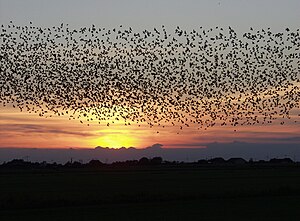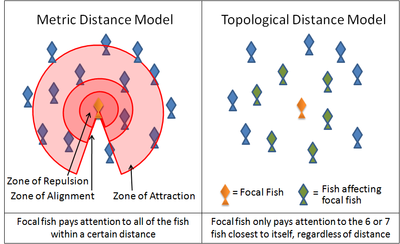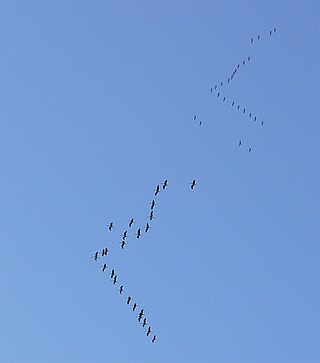
Flocking is the behavior exhibited when a group of birds, called a flock, are foraging or in flight.

Swarm behaviour, or swarming, is a collective behaviour exhibited by entities, particularly animals, of similar size which aggregate together, perhaps milling about the same spot or perhaps moving en masse or migrating in some direction. It is a highly interdisciplinary topic.

Foraging is searching for wild food resources. It affects an animal's fitness because it plays an important role in an animal's ability to survive and reproduce. Foraging theory is a branch of behavioral ecology that studies the foraging behavior of animals in response to the environment where the animal lives.

The scaly-breasted munia or spotted munia, known in the pet trade as nutmeg mannikin or spice finch, is a sparrow-sized estrildid finch native to tropical Asia. A species of the genus Lonchura, it was formally described and named by Carl Linnaeus in 1758. Its name is based on the distinct scale-like feather markings on the breast and belly. The adult is brown above and has a dark conical bill. The species has 11 subspecies across its range, which differ slightly in size and color.

A herd is a social group of certain animals of the same species, either wild or domestic. The form of collective animal behavior associated with this is called herding. These animals are known as gregarious animals.

Anti-predator adaptations are mechanisms developed through evolution that assist prey organisms in their constant struggle against predators. Throughout the animal kingdom, adaptations have evolved for every stage of this struggle, namely by avoiding detection, warding off attack, fighting back, or escaping when caught.
The Allee effect is a phenomenon in biology characterized by a correlation between population size or density and the mean individual fitness of a population or species.

The forest tent caterpillar moth is a moth found throughout North America, especially in the eastern regions. Unlike related tent caterpillar species, the larvae of forest tent caterpillars do not make tents, but rather, weave a silky sheet where they lie together during molting. They also lay down strands of silk as they move over branches and travel as groups along these pheromone-containing silk trails. The caterpillars are social, traveling together to feed and massing as a group at rest. Group behavior diminishes as the caterpillars increase in size, so that by the fifth instar (molt) the caterpillars are feeding and resting independently.

Optimal foraging theory (OFT) is a behavioral ecology model that helps predict how an animal behaves when searching for food. Although obtaining food provides the animal with energy, searching for and capturing the food require both energy and time. To maximize fitness, an animal adopts a foraging strategy that provides the most benefit (energy) for the lowest cost, maximizing the net energy gained. OFT helps predict the best strategy that an animal can use to achieve this goal.
In ecology, an ideal free distribution (IFD) is a theoretical way in which a population's individuals distribute themselves among several patches of resources within their environment, in order to minimize resource competition and maximize fitness. The theory states that the number of individual animals that will aggregate in various patches is proportional to the amount of resources available in each. For example, if patch A contains twice as many resources as patch B, there will be twice as many individuals foraging in patch A as in patch B.

Cannibalism is the act of consuming another individual of the same species as food. Cannibalism is a common ecological interaction in the animal kingdom and has been recorded in more than 1,500 species. Human cannibalism is well documented, both in ancient and in recent times.
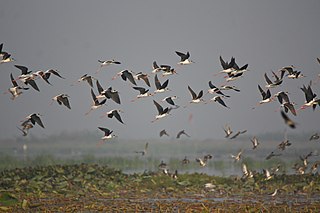
A flock is a gathering of individual birds to forage or travel collectively. Avian flocks are typically associated with migration. Flocking also offers foraging benefits and protection from predators, although flocking can have costs for individual members.
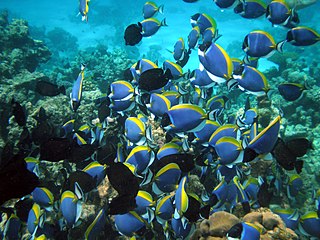
In biology, any group of fish that stay together for social reasons are shoaling, and if the group is swimming in the same direction in a coordinated manner, they are schooling. In common usage, the terms are sometimes used rather loosely. About one quarter of fish species shoal all their lives, and about one half shoal for part of their lives.

A bait ball, or baitball, occurs when small fish swarm in a tightly packed spherical formation about a common centre. It is a last-ditch defensive measure adopted by small schooling fish when they are threatened by predators. Small schooling fish are eaten by many types of predators, and for this reason they are called bait fish or forage fish.
The selfish herd theory states that individuals within a population attempt to reduce their predation risk by putting other conspecifics between themselves and predators. A key element in the theory is the domain of danger, the area of ground in which every point is nearer to a particular individual than to any other individual. Such antipredator behavior inevitably results in aggregations. The theory was proposed by W. D. Hamilton in 1971 to explain the gregarious behavior of a variety of animals. It contrasted the popular hypothesis that evolution of such social behavior was based on mutual benefits to the population.
In ethology, an aggregation is any form of gathering of organisms and the process of coming together. In some forms groups of unrelated species might form, in which interaction between members of the aggregation might be minimal; for example herds of grazing zebra and antelopes might combine, both the better to observe the approach of predators, and to improve the odds of escape in the event of attack by predators. Sometimes there might be some interaction, such as mixed flocks of birds that observe each other's foraging behaviour in searching for food. Sometimes there might be quite orderly common action, such as the queuing up for a resource; for example different species of fishes may aggregate around a cleaning station where cleaner wrasse and cleaner shrimp are active, more or less taking turns for attention. Such aggregations, where there is no particular association of species or sizes, may be referred to loosely as unstructured aggregations. Commonly they are very temporary and may be loose, with flocks or herds associating casually and separating equally casually within hours.
Vigilance, in the field of behavioural ecology, refers to an animal's monitoring of its surroundings in order to heighten awareness of predator presence. Vigilance is an important behaviour during foraging as animals must often venture away from the safety of shelter to find food. However, being vigilant comes at the expense of time spent feeding, so there is a trade-off between the two. The length of time animals devote to vigilance is dependent on many factors including predation risk and hunger.

Pursuit predation is a form of predation in which predators actively give chase to their prey, either solitarily or as a group. It is an alternate predation strategy to ambush predation — pursuit predators rely on superior speed, endurance and/or teamwork to seize the prey, while ambush predators use concealment, luring, exploiting of surroundings and the element of surprise to capture the prey. While the two patterns of predation are not mutually exclusive, morphological differences in an organism's body plan can create an evolutionary bias favoring either type of predation.

The information centre hypothesis (ICH) is a theory that states bird species live in communal roosts primarily for the advantage of gaining information from others in the community regarding the location of unevenly distributed food resources. This hypothesis was first proposed by Peter Ward and Israeli biologist Amotz Zahavi (1973). They stated that birds join assemblages in order to gain information about food resources and increase foraging efficiency. Using this strategy would allow unsuccessful birds to return to the population and gain information, often by observing behavioural differences in successful birds. Following the exchange of knowledge, the unsuccessful individuals then follow those deemed successful back to the resource location.
In ethology and evolutionary biology, group living is defined as individuals of the same species (conspecifics), maintaining spatial proximity with one another over time with mechanisms of social attraction. Solitary life in animals is considered to be the ancestral state of living; and group living has thus evolved independently in many species of animals. Therefore, species that form groups through social interaction will result in a group of individuals that gain an evolutionary advantage, such as increased protection against predators, access to potential mates, increased foraging efficiency and the access to social information.
